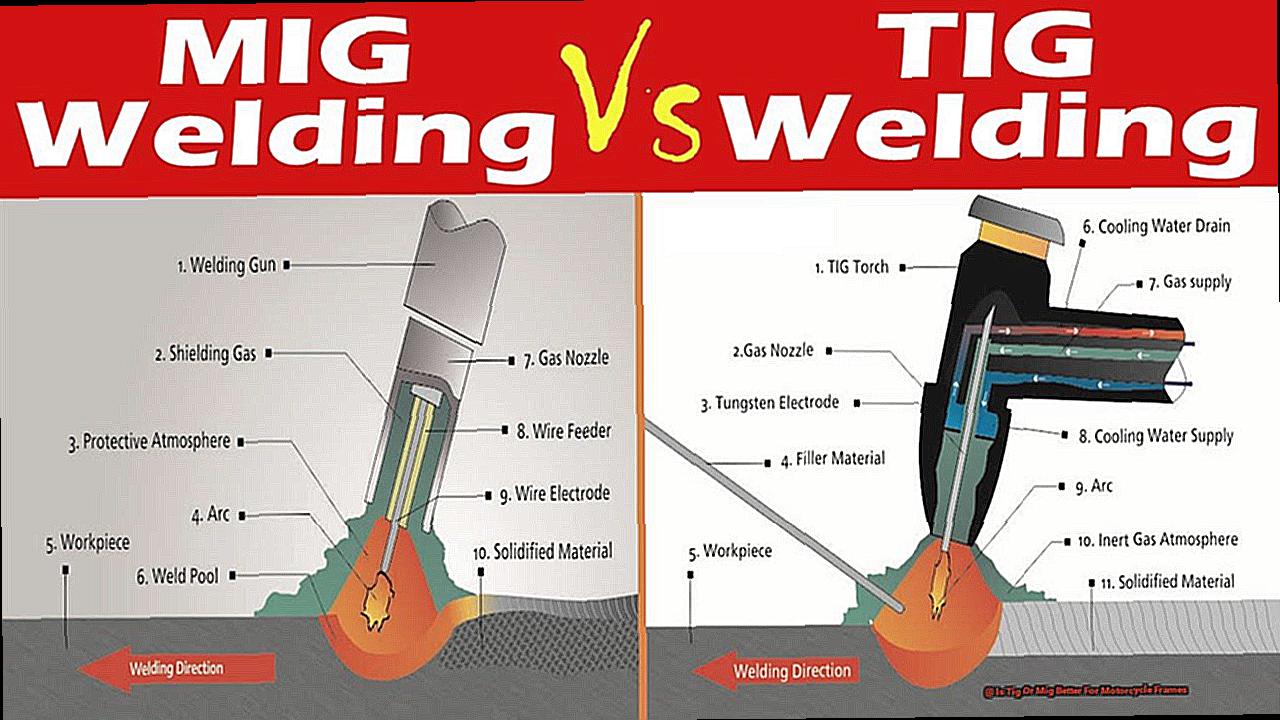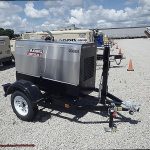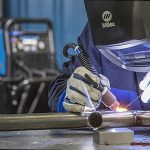It’s a symbol of freedom, adventure, and individuality. And at the heart of every motorcycle lies its frame – the backbone that holds everything together.
When it comes to building a strong and reliable frame, choosing the right welding method is crucial. Two popular options for welding motorcycle frames are TIG (Tungsten Inert Gas) and MIG (Metal Inert Gas).
But which one reigns supreme? In this blog post, we’ll explore the question on every biker’s mind: Which is better for motorcycle frames – TIG or MIG?
So, buckle up, because we’re about to take an exhilarating ride through the benefits of these two welding techniques.
Consider These 8 Motorcycle Frame Welding Techniques
Contents [show]
When it comes to customizing motorcycle frames, welding is an essential skill that every chopper enthusiast should have. However, with an array of welding techniques available, determining the right fit for your project can be perplexing. As a seasoned expert in motorcycle frame welding, I am here to simplify the process for you. In this article, we will delve into 8 distinct techniques to help you make an informed decision.
Gas Metal Arc Welding (GMAW) and Gas Tungsten Arc Welding (GTAW): The Dynamic Duo
Two of the most popular methods for welding motorcycle frames are GMAW and GTAW. GMAW, also known as MIG (metal inert gas) welding, is ideal for beginners due to its user-friendly nature. It works wonders on thinner materials and produces robust welds.
On the other hand, GTAW is renowned for its clean and visually appealing welds as it does not require a filler metal. However, it requires an external gas supply and can be more challenging to master.
Other Welding Procedures: The Versatile Alternatives
Apart from GMAW and GTAW, other welding procedures may be used depending on your project’s goals. These include laser beam welding, plasma arc welding, stick welding, atomic hydrogen welding, and electroslag welding. Each method offers unique advantages but may necessitate specialized equipment or skills.
Flux Core Arc Welding (FCAW): The High-Heat Option
FCAW is a high-heat method that excels in welding thicker metals but requires extensive cleanup. It employs a flux-cored wire along with an external gas supply to create robust welds.
What Makes the GMA and GTA Welding Processes Ideal for Motorcycle Frames?
When it comes to customizing a motorcycle frame, the choice of welding method is paramount. This is where GMA and GTA welding come into play. These two techniques, also known as gas metal arc welding (GMAW) and gas tungsten arc welding (GTAW), offer a winning combination of adaptability, simplicity, accuracy, strength, and aesthetic appeal that make them perfect for motorcycle frame customization.
GMA welding, also called MIG welding, is a popular option among DIY enthusiasts due to its uncomplicated nature and versatility. It utilizes a wire electrode and shielding gas to safeguard the weld from corrosion, making it ideal for creating robust and long-lasting welds on motorcycle frames. Furthermore, it can be executed in a garage or workshop with relatively basic equipment.
On the other hand, GTA welding, also known as TIG welding, provides precise and visually pleasing welds without the need for filler metal. This renders it an exceptional choice for customizing motorcycle frames that require neat and exact welds. However, mastering it may require more experience compared to GMAW.
But what about other welding methods? While there are various options available such as MIG, TIG, stick welding, laser beam welding, and plasma arc welding, GMA and GTA still reign supreme as top choices for motorcycle frame customization. For instance, stick welding may be cost-effective but can result in untidy splatters. Laser beam welding and plasma arc welding offer high temperatures for robust welds but may be challenging to master or require specialized equipment.
When selecting a welding method for customizing motorcycle frames, it is vital to consider the type of base metal being used. For instance, DOM steel tubing is commonly utilized in motorcycle frames and necessitates a specific approach for optimal outcomes.
In conclusion, GMA and GTA welding are the dynamic duo when it comes to customizing motorcycle frames.
What type of metal is used to construct motorcycle frames?
When it comes to the fabrication of motorcycle frames, the type of metal utilized plays a vital role. It serves as the backbone of the bike, providing durability, stability, and visual appeal. As an authority in the field of motorcycle frames, I have observed numerous welding techniques and materials being used. In this section, we will delve deeper into the common materials employed for constructing motorcycle frames and compare two prevalent welding methods: TIG and MIG.
Let’s first discuss the material. DOM (drawn over mandrel) steel tubing is considered the top choice for building motorcycle frames. This type of steel is renowned for its robustness, quality, and uniformity. It is also widely available and affordable, making it a popular choice among manufacturers and DIY enthusiasts alike.
Now, onto the main event: welding techniques. TIG (gas tungsten arc welding) and MIG (gas metal arc welding) are the top contenders in the realm of motorcycle frame welding. So which one reigns supreme?
Well, that depends on your project objectives and expertise. TIG welding offers precise control over the weld, resulting in a spotless and sturdy final product. It is ideal for intricate designs or repairs that require meticulous welding. However, it requires a higher level of proficiency and patience to master.
On the other hand, MIG welding is easier to learn and can be completed at a faster pace due to its continuous wire feed. This makes it a favored choice for large production runs or simpler designs that do not demand as much accuracy. However, MIG welds may not be as visually pleasing as TIG welds due to potential spatter and slag.
Regardless of which method you opt for, safety should always be a top priority. Proper equipment preparation, including cleaning the metal surfaces and wearing appropriate protective gear, is crucial for achieving optimal results. Additionally, practicing good technique and following safety protocols can prevent accidents and ensure a successful weld.
Use These Best Practices Before Welding
As a welder, utilizing proper techniques before embarking on any project is crucial to achieving desired results. Whether you are a novice or a seasoned welder, understanding the distinctions between TIG and MIG welding methods, taking into account the type of metal being used, and conducting a trial weld are essential steps in ensuring a successful welding endeavor. So, before donning your welding helmet and jumping into perfecting that motorcycle frame, let’s delve into these best practices to guide you in making informed decisions.
TIG vs. MIG: Identifying the Ideal Technique for Welding a Motorcycle Frame
TIG (Tungsten Inert Gas) and MIG (Metal Inert Gas) welding are two widely used techniques in the welding world. While both have their own set of advantages and drawbacks, it is vital to determine which one suits motorcycle frame welding better, based on specific project requirements.
TIG welding employs a non-consumable tungsten electrode to create the weld, resulting in a precise and clean finish. This makes it ideal for intricate and delicate projects like motorcycle frames. On the other hand, MIG welding uses a consumable wire electrode, making it faster and more efficient for larger and thicker pieces of metal. Therefore, if you are working on a more intricate motorcycle frame, TIG welding may be the better choice for a seamless finish. However, if time is of the essence and you are dealing with thicker pieces of metal, MIG welding may be the more practical option.
Consider the Type of Metal Being Used
Another crucial factor to consider is the type of metal used for the motorcycle frame. TIG welding is better suited for thinner metals like aluminum, while MIG welding is more suitable for thicker metals such as steel. Since most motorcycle frames are made of steel, MIG welding may be the more appropriate choice. However, if the frame has any delicate or thin sections, TIG welding may be necessary to avoid warping or damage.
Conclusion
In conclusion, the motorcycle frame is not just a mere structural component, but a powerful symbol of freedom and self-expression. Throughout this article, we have delved into the importance of choosing the right welding method for creating a sturdy and reliable frame. While there are several options available, TIG and MIG have emerged as top contenders due to their versatility, simplicity, precision, strength, and aesthetic appeal.
When faced with the decision between these two techniques, it is crucial to consider both the specific project requirements and your level of expertise. TIG welding may be better suited for intricate designs or repairs that demand meticulous control over the weld, while MIG welding may be more efficient for larger production runs or simpler designs.
Furthermore, the type of metal used for the motorcycle frame must also be taken into account. DOM steel tubing is commonly chosen for its durability and accessibility. Depending on the type of metal being used, one technique may prove to be more suitable than the other.
Before embarking on any welding project, it is imperative to follow best practices such as understanding the differences between TIG and MIG welding methods and conducting a trial weld to ensure optimal results. Safety should always remain a top priority when working with welding equipment.
In summary, whether you opt for TIG or MIG for your motorcycle frame welding needs, proper technique and safety measures are essential in achieving a robust and visually striking final product.





